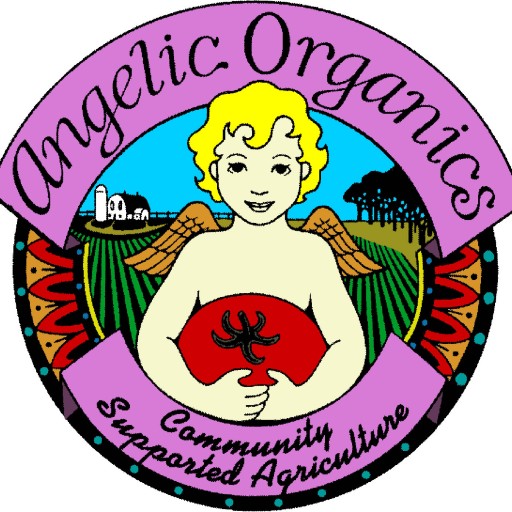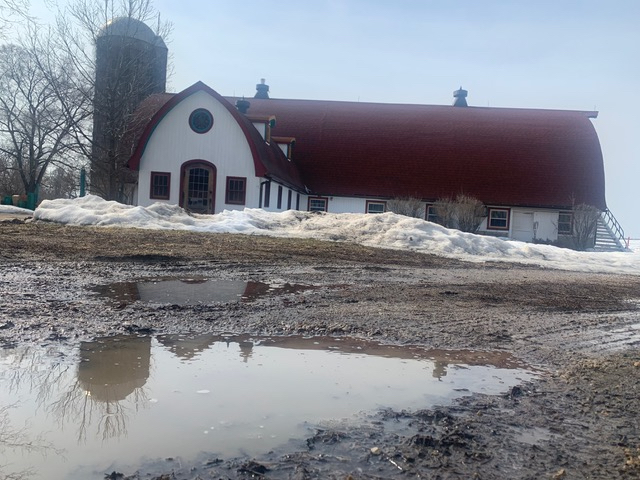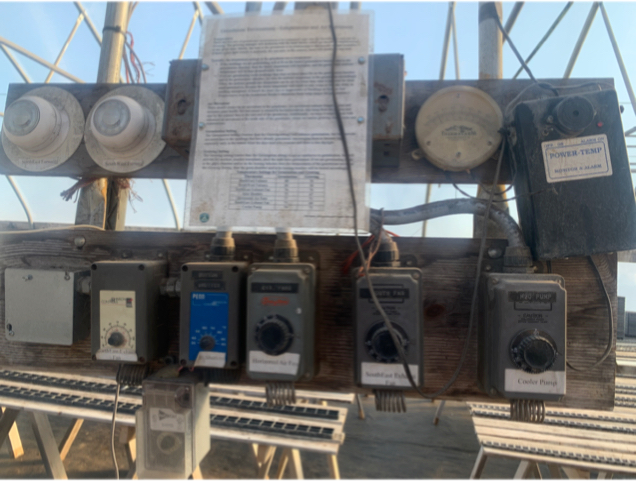Farmer John Writes: The Thaw, My Sister, and Your Share
It’s time for an update from Angelic Organics–maybe past time, but my stellar year-round crew of four and I have been so busy since the last season ended, I haven’t found time to properly stay in touch with you. The narrow winter window on this farm is fully filled with machinery repair, building maintenance and upgrades, research, and planning the next season. The recent thaw has put us into overdrive. The melting snow and mud hasten us to prepare for another season of growing healthy, abundant vegetables and herbs for our shareholders.
As the Snow Thaws, Shares are Available
Speaking of time, if you haven’t signed up for a 2021 CSA share yet and you plan to, I suggest that you sign up now at CSAWare, because I am not sure how soon we will sell out of 2021 shares. (If you are not familiar with our CSA program, please visit Receive Our Vegetables to learn more before signing up for a share.)
The Passing of my Sister, Mary Jane
Also, speaking of time, my older sister Mary Jane Lewis passed away this winter. Mary Jane grew up on this farm. She was a real farm girl. She helped with chores, drove tractors, and showed cattle at the fair.
Mary Jane was a lot of fun and the source of great childhood excitement and adventure.
She went on to teach school in Kenosha, Wisconsin, for 35 years, and touched the lives of many of her students. My wife Haidy and Mary Jane also formed a warm friendship in the last several years.
Here is Mary Jane’s obituary.
My sister Carol Krupke and I will miss our spunky sister Mary Jane.
The Greenhouse
I will share with you the main winter project here this year–an upgrade of our greenhouse where we start all of our seedlings. We built the greenhouse in the mid-90’s. Overall, it has served the farm quite well, though it is now a bit undersized for all the growing that we do. In assessing its needs this winter, quite a long list of tasks emerged.
Water Wandering Long Before the Greenhouse was Built
Going back a few decades before the greenhouse was built, we had issues with water from rain or melting snow coming down the hill from the south and making its way into our buildings. I wouldn’t call it flooding exactly, but it was still a problem, especially in spring. So, in 1973, I had a deep ditch/waterway carved into the hill just south of the farmstead and had it wrap around to the west and head towards the Mississippi—better there than through our barns. This helped considerably to keep water away from the farmstead, but not enough. Rain and melting snow still make their way into the east end of the greenhouse, along with some mud they pick up along the way, and then run the length of the greenhouse and out the other end. This has been a problem since we built the greenhouse. (Yes, I could have sited the greenhouse better, but I don’t do everything right.)
Water Wondering
For the past couple of decades, I have imagined how we could get the ground water to stop coming into the greenhouse. We now have a solution to this problem, which will require concrete, a trough, a sump pit and a sump pump (and probably a bit more). This will be somewhat transformational for the greenhouse and for the people who work there.
Weeds and Wood
In our detailed assessment of the greenhouse, we determined that the porous weed barrier covering the floor was so degraded that it had to be replaced. We also decided that the wooden walkways were unacceptably dangerous, due to rotting boards, so we resolved to replace the wooden walkways.
Whatnot
Putting attention on a place/project/person can reveal all sorts of additional heretofore unnoticed or barely noticed wants and needs. You might find the following considerations a bit circuitous, but a farm project, like one’s life, involves many considerations, some of which relate to one another, and some of which might at first seem extraneous and un-related, but are nevertheless integral.
If Not Watering, then What?
Nathan Hallgren, our greenhouse manager, has in prior years been spending maybe 3 hours a day watering the greenhouse. This goes on for several months into about the middle of the growing season. He does a good job, but those 3 hours each day can be applied more productively in other areas of the farm, since he has myriad skills in the areas of IT, administration and research. For example, Nathan can fill out a daunting mandatory government form (we get dozens per year) in about the same amount of time that it takes me to read it through the first time and then sit there wondering what it was all about. Should Nathan be filling out these forms for me, or directing his watering wand at our seedlings for 3 hours per day, even though it can be automated, while I stare blankly at the required forms?
There’s also the issue that I arrange for a substitute greenhouse waterer on Sundays, so Nathan doesn’t have to drive out to the farm to water the seedlings. I don’t have time to do this watering, as it would conflict with my relentless weekend farm work. Weekend watering performance has been uneven here, to put it gently. There is too much at stake to assume that the substitute waterer will water properly or even remember to water. It is painful to face wilted seedlings that on a Sunday afternoon that are supposed to end up on your table because a volunteer neglected to water.
As a consequence of Nathan’s broad skill set and the weekend watering demand, we need an automatic watering system for our greenhouse. We consulted with the most helpful and congenial Carl Duewer of All-American Associates on this watering/irrigation project. (I purchased the original structure from Carl 25 years ago.) Setting up a watering system for a greenhouse might seem easy, but it’s complicated. How wide will the benches be? How high? Spaced how far apart? How many irrigation zones are wanted? How high will the tallest plant be above the flat? Do we want to mist the plants or drench them? Will each nozzle have a shut-off valve? How much water pressure is there? How much water volume? Then there’s the iron.
What’s Iron Got to Do With It?
We realized that we have to install an iron filtration system so that the iron in our water won’t plug up the nozzles, which would result in Nathan hand watering and my struggling with numerous government forms instead of managing the farm. The iron filter salesman pointed out that our water volume was too low for the iron filtration system to work. (We currently have two iron filtration systems on the farm, but they only handle residential needs and do not include the greenhouse. They stopped working when the water volume dropped this winter.)
A few years back, we had put in a new well pump. I knew that our current water volume should have been adequate to power our current iron filtration systems and any new one we added. I had the guys from Bloyer Well and Pump come out to do an inspection. They said there was something wrong with our pump or something was wrong with the water line from the pump to the ground level.
Pumping Iron
I’ll slightly digress here, and explain why our water has so much iron in it. In the 90’s, the health department didn’t like that we had a shallow well, which provided delicious clear water, and they demanded that we put in a deep well, which provided rusty-looking water with iron in it. (Pretty much all the deep wells in this region have excessive iron in their water.) Some of you might remember back when this drama of drilling the new well occurred. It’s a much longer story than that, but I won’t elaborate. The well is now over 300 feet deep, and our pump sits 160 feet down in that well.
The well technicians pulled the pump last week and found that that there was a sizable hole in the pipe leading up from the well, probably caused by the excess iron. Water had likely been spewing from this hole for a long time, causing the water pressure and volume to drop. (The electric bill this winter was very large, and now I know why—because the well pump was running continuously.) I suspect that the county thinks they solved a big problem by making us drill a deep well for thousands of dollars. It has cost the farm several more thousands of dollars since then in ruined pumps, plugged nozzles, iron filtration systems, and an enormous electric bill for unwittingly continually pumping water through an underground pipe ruined by iron. There has also been the never-ending task of scrubbing away iron deposits.

galvanized pipe caked with iron; notice the large split due to iron buildup in the perpendicular pipe near the coupling
I had the well technicians install a new pump and a new pipe from the pump to the wellhead.
Prior to installation the water pressure was 30 psi; now it averages 60 psi. Prior to installation, the volume was maybe 12 gallons per minute; now it is close to 50 gallons per minute. The water pressure and volume are again adequate to power the iron filtration system. (This is the water used for residential needs, washing your vegetables, drip irrigation, and the greenhouse.)
Where Were We?
Remember, this is a greenhouse upgrade. So far, we have had to put in a new well pump, new water line to the ground surface, new weed barrier on the greenhouse floor. We have also done a major re-configuration of the layout of our greenhouse benches. We have ordered the components for the automatic watering system.
We still have to build boardwalks, install the components for the greenhouse irrigation system and get the new iron filtration system installed. There’s more.
Sprung Springs
I should also mention that the springs in the thermostats in the environmental control panel are worn out. The thermostats are not at all accurate, which means we can’t properly control the important functions of air flow and temperature control. We have to install a new temperature control panel.
Posted Roads and The Thaw—Good Lines to Use about Your Share Purchase
And then there’s the concrete work. We can’t do that project yet, because the roads are posted due to the seasonal thaw, which makes the paved roads less durable. The cement truck can’t come out here until sometime in April, when the roads are no longer posted. In April, we are often too busy getting into the fields to pour concrete, but sometimes, I get something in my head about something that needs to be done and I get single-minded about it and it gets done.
Will we still have shares available, once those postings are lifted? I suggest that during this rite of spring–the thaw and the posting of the roads–it’s a good time to consider buying a farm share at CSAWare, if you haven’t already signed up for 2021.
Then you can have conversations like this:
“When did you purchase your share?”
“Oh, back when the roads were posted.”
or
“When did you purchase your share?”
“During the big thaw.”
Those are answers that will make you feel close to the workings of the earth.
Soon
A Small but Big Matter
All of these improvements qualify more or less as an infrastructure upgrade of one building out of our twelve farm buildings. It’s not an upgrade of the actual seeding or growing of the transplants; the upgrade simply facilitates the growing of the transplants. It supports the mission of the greenhouse–seedling production–and seedling production is just a subset of growing. We set all the greenhouse transplants out in our fields, and do direct seeding of many other crops directly into the fields, so the fields are where most of our growing takes place. The greenhouse infrastructure is a subset of the greenhouse production which is a subset of growing.
Yet, this greenhouse infrastructure project will cost the farm upwards of $30,000. In the grand scope of running the farm, it is a small project, but it will still cost a lot of money.
Farming is interesting, no?
Happy Spring, Coming Soon,
Farmer John














I read every word and feel as though I’ve been listening to you talk, in person, and am so very glad. Holy moly you did an excellent job illuminating the complexity of farming, and the time and creativity (and money) it takes. May 2021 be full of just enough projects to stimulate and not so many to exhaust. Miss you.
Sheri, So nice to receive this lovely message from you. Farming is its own world, no? But it is also everyone’s world, though everyone doesn’t know it. I hope all is well with you. Hug.
So sorry about the loss of your sister but happy to hear you and your wife enjoyed her life. Blessings to the work you do toiling the land for our food.
Thank you for the blessings and the condolences.
I’m so sorry you’ve lost your sister. While it’s never a “good” time to lose someone close to us, Covid times make things more difficult. We’re already so detached from one another, but a loss conjures up thoughts from the past that almost seem surreal in relation to how we experience life now. I expect though with all the work you’ve described that you’ve been too busy to think. Yikes ! My mother grew up a city gal in Chicago, and she always wanted to marry a farmer. Every summer she & her family visited the Ingelsens on the farm where my grandmother’s dear friend Jenny lived. She talked about how good she felt doing chores every day, & rising early to the crowing rooster alarm clock. She said she never had time to worry about anything before she fell asleep. The sheer exhaustion she felt every day put her right to sleep.
This is a beautiful story about your mother. Yes, farming the way we do here allows almost no time to dwell. When my dad died when I was 19, I did the chores and milked the next morning, the next evening, and on and on and on. This farming life is a blessing and a curse in that way, as we need time to grieve, but a farm teaches us that life goes on. I will add that I feel very close to Mary Jane now, even though she is on the “other side.”
It was the thrill of my life meeting you. Then Igot to have a picture taken with you. Being a farmers daughter, in my heart I feel your pain of farming. And I certainly feel your pain wirh the loss of your precious sister. Gods speed.
The pain of farming–yes, it is a very challenging path; every day seems like a rite of initiation. It is glorious, dangerous, fulfilling, discouraging, inspiring, and always interesting. It is full of heartaches and joys. Thank you for the condolences for my sister’s passing.
My condolences on the loss of your sister. At every meal we say a blessing for the farmers.
Thank you for your condolences and thank you for your blessing of the farmers. Much appreciated.